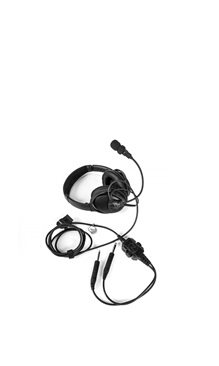Cable swap
Dalcomm Tech headsets for whatever you fly

David Clark didn’t use those ideas, and Clark eventually founded his own company that sells aviation headsets and hearing protection for ground crew, among other items.
One such innovation is an interchangeable cable. This means you don’t need to buy two headsets or a separate adapter if you happen to fly both fixed- and rotary-wing aircraft. Simply swap out the cable for the aircraft you’re flying and go on your way. What’s more, Dalcomm offers a cable that allows you to hook up its headset to a flight simulator, and one that allows the user to plug in and transmit over an intercom or radio.
Dalcomm sent us two headsets to test-fly, and we were pleasantly surprised almost the moment we got the items out of the box. The J1 model is constructed of carbon fiber and weighs just 10 ounces. No head clamping; they rested comfortably on two pilots’ heads and stayed in place during some simulated turbulence, aka violent head shaking. The sound quality was excellent, and the headset has a noise reduction rating of 23 decibels. We loved the headset’s 3.5 mm aux audio input port on the ear cup. Use this to plug in your smartphone or tablet and listen to music.
The J7 comes in a little heavier at 14 ounces but offers the same fine audio sound quality and construction at a lower price. Clark said a customer who doesn’t want standard black head cups can call the company and order from a selection of colors that can be 3D printed on demand; that option is not yet on the website, he said.
Both models can be customized with choice of ear seals and adapter cords. Some models will require a separate, optional microphone to use with various types of cords, which are sold separately. The headsets come with a 65-month warranty, one adapter cord, one aux cable, and a bag.
Price: J7 $320.25; J1 $446.25
dalcommtech.com
Update your favorite headset with Bluetooth
 When I began flying lessons in 2000, I sprung for a robust active noise reduction (ANR) headset, one that I felt would take me through my private pilot training and beyond. Of course, that was years before iPhones or Androids were part of our daily life along with their entertainment choices and powerful aviation apps. Accompanying safety enhancements like audio callouts for terrain avoidance, runway entrances, ATIS frequencies, and flight service phone calls for clearances would sure be nice to have.
When I began flying lessons in 2000, I sprung for a robust active noise reduction (ANR) headset, one that I felt would take me through my private pilot training and beyond. Of course, that was years before iPhones or Androids were part of our daily life along with their entertainment choices and powerful aviation apps. Accompanying safety enhancements like audio callouts for terrain avoidance, runway entrances, ATIS frequencies, and flight service phone calls for clearances would sure be nice to have.
Instead of ditching our “old reliable” headsets, update them to Bluetooth audio technology with the Faro Stealth Audio Link for less than $150. The Stealth Audio Link plugs into the tail end of a dual-plug aviation headset and adds wireless Bluetooth technology to your audio and communication capabilities. An audio priority feature mutes music or other inputs during radio calls, then resumes after the transmission ends. Dual inline volume knobs provide additional audio adjustability, and a separate Bluetooth volume toggle can control your linked device’s output. A 3.5 mm auxiliary-in jack allows hard-wiring to external devices.
The unit is powered by AA batteries or a USB Type C power input. The Bluetooth module adds about 26 inches to the headset’s cord length, so be careful not to get wrapped up in it. The Faro Stealth Audio Link works with and modernizes many headsets manufactured prior to the advent of built-in Bluetooth technology—which can drive the price of some new ANR headsets to more than $1,000.
[email protected]
Price: $139.95
sportys.com/faro



